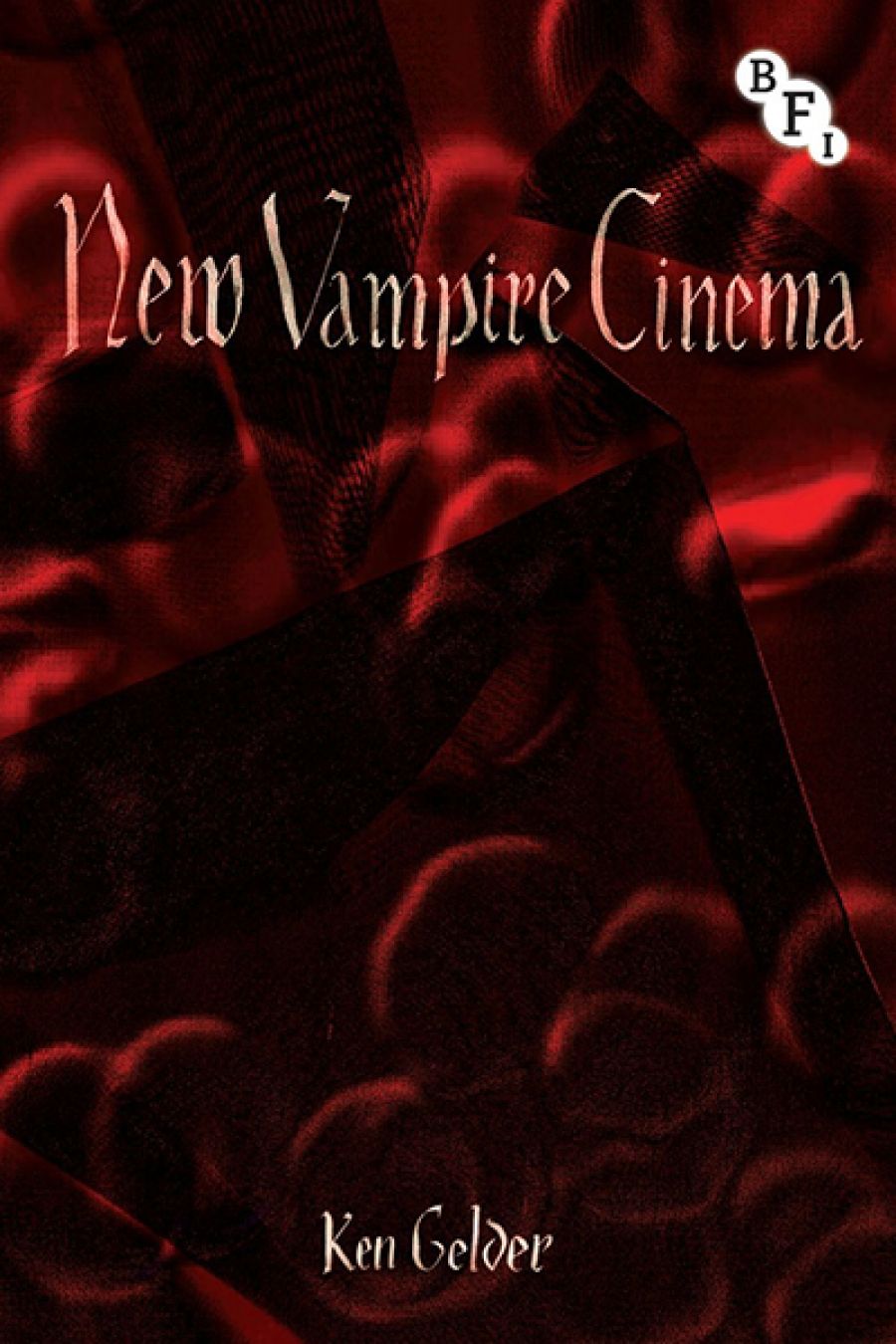
- Free Article: No
- Contents Category: Film
- Custom Article Title: Michael Fleming reviews 'New Vampire Cinema' by Ken Gelder
- Review Article: Yes
- Article Title: Vampirology
- Online Only: No
- Custom Highlight Text:
The myth of the vampire entered into European literature as a Byronic hero of the Romantic era. This attractive but evil character appears to have shifted from peasant folklore into the written culture at the same time that Lady Caroline Lamb described Byron as ‘mad, bad and dangerous to know’. That would be a perfect description for the classical vampire. Although the demonic figure that lives on blood has an ancient pedigree, it is significant that the modern vampire, the one we are familiar with, is parasitic on Christian mythology. The paraphernalia to ward off vampires are such as to give comfort that ultimately the evil of the vampire is powerless against the Good of the Christ. That evil is of central importance to the myth. The vampire is an erotic dream of the desires forbidden by Christian taboos. In most cases the taboo can read as a fear of disease, especially sexually transmitted diseases. In the nineteenth century, this fear of such diseases as syphilis and ‘consumption’ (tuberculosis) was unspoken, but expressed as metaphor. The three classic texts from which most vampirology derives – Polidori’s The Vampyre (1819), Sheridan Le Fanu’s Carmilla (1872), and Bram Stoker’s Dracula (1897) – are all essentially Christian, and erotic, in their symbolism. The descriptions of the symptoms of those infected by the vampire were very familiar to the readers of the day. So for nigh on two hundred years the vampire has roamed our nights striking fear but, at the same time, instilling desire.
- Book 1 Title: New Vampire Cinema
- Book 1 Biblio: British Film Institute/Palgrave Macmillan, $39 pb, 164 pp
The persistence of vampires in popular culture is a phenomenon which has not gone unnoticed. This has been the case in literature, but also, perhaps especially, in film. The puzzle is that since the vampire is so specifically supernatural, indeed Christian and irrational, one would expect that the increasing secularisation of Western culture would presume the death of the supernatural, especially the irrational vampire.
Ken Gelder’s book examines the surprising persistence and popularity of vampires over the last twenty years. The chief value of the book is as a general survey of the many films released that in some way relate to this genre. Given the number of films involved, the ideas relating to them are never developed to any great extent. The book can be regarded as an invitation to others to develop further some of the ideas therein. Indeed, there are ideas which Gelder puts forward which deserve and indeed require development through discussion and debate.
The book is divided into five chapters representing five different aspects of vampires in the recent past. He begins with the opposition of the traditional, ‘authentic’ vampire and the revisionist, ‘inauthentic’ postmodern iterations, particularly Buffy the Vampire Slayer (1992). The latter is only addressed through the original film, although Buffy became far more interesting in the ensuing television series. This is followed by chapters on the problems of survival for a vampire in a contemporary urban environment; the ability for films to cite vampire tropes without really being a vampire film; the grand sagas of the vampire in the Americas; and, finally, the struggle for survival of the vampire as a species in the Darwinian mode.
In the chapter on vampires in America, Gelder posits that the narrative of American-based vampire films can be read as that of coloniser–colonised. This is valid but ignores a pertinent notion – the vampire has always been a refugee. Since vampires in Western culture are parasitical upon Christian mythology, it is logical for the vampire to seek refuge in those parts of the world where they are taken seriously. This is particularly the case with the Twilight films. Gelder reads the films as a particularly strong allegory of the coloniser–colonised narrative. This is because the two male protagonists of the series are a European vampire and an American Indian werewolf. As Gelder rightly notes, the fantasy in the Twilight films is as much about class as it is about anything. The vampires are, as usual, somewhat aristocratic, the werewolves are chthonic, of the earth; Bella, the human, is somewhere in the middle. This hierarchy is inherent in the narrative but never made explicit.
Unfortunately, the Twilight series is a rather unsatisfactory attempt to de-queer the vampire. As Gelder notes, ‘the franchise is usually seen as advocating a sexually conservative morality’. Edward, our Byronic and morally compromised hero, is torn by Bella’s desire to marry him and be ‘turned’, a plot point lifted from the film Son of Dracula (1943). As usual in these ‘colonist’ vampire films, there is a clan of Old World vampires who are decadent, sexually dubious (read Queer), and who try to corrupt the upright American vampires. Gelder does not directly address this allegory of world politics; nor does he tackle the fact that the narrative attempts to prevent any queer reading of vampires at all. However, when Jacob the American Indian reaches puberty and becomes a werewolf, his habits change from consorting with nice girls to hanging out in the woods with a bunch of naked males, a change, he protests to Bella, that is ‘not a lifestyle choice’. Things in the woods are very queer indeed. The vampire may have been heterosexualised, but those queer ideas just won’t be repressed.
If nothing else, reading this book prompts debate with the author’s ideas. In that respect it is engaging to read, imaginative in its analysis, and wide-ranging in its knowledge of recent vampire history.


Comments powered by CComment